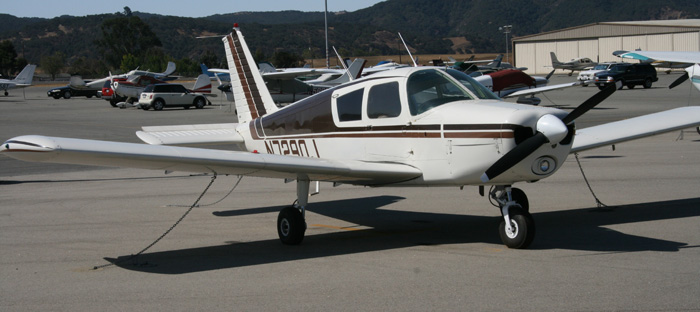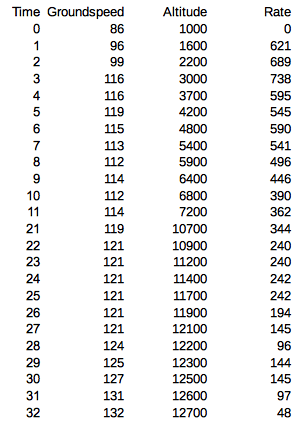
Maintenance
 Serial # 28-24642
Serial # 28-24642O-320-E2A
Engine installed 3798 Hours 2009-03-03 with Lycon 160 HP STC SE00252SE
Wing Spar AD 2020-24-05 Complied with by Borescope Inspection
Maintenance Checks: Time Based
Annual Done at 5267.0 Due November 30, 2024Pitot Static/Altimeter Due
Transponder Due May 2024
ELT Due August 2025
Registration Expires 01/31/2028
Maintenance Checks Due: Hourly Based
Magneto 5424Maintenance Checks: Pre-flight Based
Oil ~6 quarts. Minimum 2 quarts.Nose Wheel Strut Extension 2.75"
Main Wheels Strut Extension 2.0"
Tire Pressure 24 lbs.
Parts Replacement
| Part | Replacement Date | Hours |
|---|---|---|
| Oil | 2023-08-03 | 5247.7 |
| Tires—Right Main | 2019-01-01 | 4849.6 |
| Tires—Left Main | 2022-08-13 | 4996.0 |
| Tire—Nosewheel | 2019-10-20 | 4896.1 |
| Brakes | 2019-01-01 | 4849.6 |
| Battery | 2019-05-08 | 4856.0 |
| Magneto Overhaul | 2021-07-30 | 4924.1 |
| Starter | 2012-02-24 | |
| Spark Plugs | 2017-12-06 | 4755.5 |
Manuals
ServiceParts
Torque Values
Nosewheel 90 inch-lbsMains 195 inch-lbs
Spark Plugs 30-35 foot-lbs
Documents

N7290J is a P28A/U for flight following.
There are a couple of checklists in the airplane. I printed my checklist on 3x5 cards and put them in a photo album. I also have colored cards with emergency checklist items, one with weather minimums, V speeds, and other things that I want to know. Some of that info is handwritten and some is on the checklist document. Here are the current pdf and editable versions of my Cherokee checklist. I use Bean for simple editing, so you may have to adjust the format a bit if you use something else.
Download the Weight and Balance pdf.
Weight and Balance on-line calculator.
Download a Weight and Balance Spreadsheet xls.
The Type Certificate Data Sheet, which is a part of Type Certificate 2A13, prescribes conditions and limitations under which the product for which the type certificate was issued meets the airworthiness requirements of the Federal Aviation Regulations. This airplane was certified under CAR 3. The PA-28 TCDS was used for a variety of aircraft with many variations in engines, props, maximum weight, and names. Among other information, the TCDS includes airspeeds—VNE, VA, CG range, Maximum Weight, and Fuel Capacity. The information for this Cherokee, Serial Number 28-24642, is found in section VIII - Model PA-28-140 on pages 11 and 12. Download TCDS pdf (1MB). You can also view just the pages relevant to N7290J.
The Airplane Flight Manual has the weight, ARM, and Moment for all of the installed items (engine, prop, radios, instrument cluster, etc.) as well as optional equipment that was available from the factory. It also contains the computed empty weight, ARM, and moment when this airplane left the factory—June 4, 1968. Download the Airplane Flight Manual pdf (2MB).
This airplane has a Lycoming O-320-A engine that has been upgraded by Lycon to produce 160HP. The upgrade decreases the takeoff roll, increases the service ceiling, and slightly increases the cruise speed. It does not change the gross weight or stall speed. Download the Lycoming Operator’s Manual O-320-A pdf (8MB) and the Lycon Supplemental Manual for the 160HP Engine STC pdf (8MB).
Owner’s Handbook pdf
Garmin SL30 Radio User Guide pdf
Audio Panel Pilot’s Guide pdf
Stratus ESG Pilot’s Guide pdf
Gene Whitt’s Handling Notes
Wikipedia’s page on the PA28 series.
Commercial Maneuvers
PDF version.
Editable Keynote version.
Maximum Climb Performance
On a hot day the Cherokee takes forever to climb. But on crisp January mornings, it climbs like a real airplane—1,500 fpm on takeoff is not unusual. So I wondered how well it would perform on a typical crisp morning.
I climbed to 12,800' on a cold (for here) day 10°C to start and -20°C at 12,800'. At 2,000' on left downwind at the numbers! After initial climb, maintained 500 fpm though FlightAware has higher numbers. Kept the RPM at the top of the green and leaned aggressively. Even though winds were calm on the surface, there was a strong tailwind so groundspeed was phenominal. Indicated was closer to 90 mph and got down to below 80 at the end. Total distance was about 55 nm from KSPB to GVO via V27. My timing matches FlightAware, but I topped out at 12,800 over GVO.

I returned at 500 fpm and flew the RNAV 29 approach. Total fuel burn was 11 gallons and time aloft was 71 minutes.
Climb and Descent
I have been taking the FAA knowledge tests lately and they have questions where you need to calculate fuel burn and time. They always give you the climb and descent time and burn, presumably it is in newer AFMs. It is not in mine. We’ve had a couple of pretty close to standard days lately with no wind, so I decided to see what my numbers are.
KSBP to 5,000' MSL
To estimate time and fuel burn I did two flights to 5,000' MSL. Total fuel burn for the two flights was 4.7 gals and total time was 1.0 hours.
KSBP to FABEG
To estimate time and fuel burn I did two flights from KSBP to FABEG and the RNAV 29 Approach. I reached 5,500' MSL before reaching FABEG so I started the descent and reached 3,300' MSL at FABEG. Total fuel burn for the two flights was 13.3 gals. and total time was 1.1 hours. I started out at around 800 fpm and was never less than 500 fpm. Neither flight was direct to FABEG since I had to extend my departure on the first flight and extend my crosswind leg on the second for traffic. Total distance was 80 nm, so 40 each. Total time including taxi time was 68 minutes. Flight time was closer to 26 minutes for each leg.
Cherokee vs Cessna 172
Landing is a Breeze
Great day for Flying!

Touring Machine Company is a web site that has general information about subjects that are on the practical and written tests as well as information on web sites for flight planning, weather, TFRs, and more.


